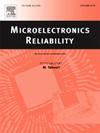1.2 kV/ 20a 4H-SiC肖特基势垒二极管在湿度和高反向偏置电压下的失效机理
IF 1.6
4区 工程技术
Q3 ENGINEERING, ELECTRICAL & ELECTRONIC
引用次数: 0
摘要
SiC功率器件具有比硅基器件更高的阻断电压、更低的导通电阻和更高的工作温度,可广泛应用于电动汽车、轨道交通、高压输电等领域。但是,越来越苛刻的应用环境对其可靠性提出了更高的要求。本文通过高温存储(HTS)、低温存储(LTS)、高温反向偏置(HTRB)和高压、高湿、高温反向偏置(HV-H3TRB)等一系列可靠性试验,对1.2 kV/20 A SiC肖特基势垒二极管(sdd)进行了可靠性评价。所有器件均通过HTS、LTS和HTRB测试,但只有80%的器件通过HV-H3TRB测试,这主要是由于在1200v之前预击穿造成的。失效分析表明,击穿点位于裂纹端部边缘,钝化层出现脱层现象。在HV- H3TRB后80%的失效器件中,几乎都表现为钝化层损伤失效模式。有了根本原因,故障机制已经确定。这表明钝化层对决定SiC SBD器件的可靠性起着至关重要的作用。本文章由计算机程序翻译,如有差异,请以英文原文为准。
A failure mechanism of 1.2 kV/20 A 4H-SiC Schottky barrier diodes under humidity and high reverse bias voltage
SiC power devices have higher blocking voltage, lower on-resistance, and higher operating temperature than Si-based devices, which can be widely used in electric vehicles, rail transit, and high-voltage power transmission. However, the more severe application environments put higher demands on their reliability. In this paper, 1.2 kV/20 A SiC Schottky Barrier Diodes (SBDs) were evaluated after subjected to a series of reliability tests, including high-temperature storage (HTS), low-temperature storage (LTS), high-temperature reverse bias (HTRB) and high voltage, high humidity, high temperature reverse biased (HV-H3TRB) test. All devices passed the HTS, LTS and HTRB tests, but only 80 % of the devices passed the HV-H3TRB, which was mainly caused by pre-breakdown before 1200 V. Failure analysis showed that the breakdown point was located at the edge of the termination with cracks and delamination of the passivation layer were observed. Of 80 % of the failed devices after HV- H3TRB, almost all showed failure mode of passivation layer damage. With the root cause, the failure mechanism has been identified. This indicates that the passivation layer plays a critical role to determine the reliability of a SiC SBD device.
求助全文
通过发布文献求助,成功后即可免费获取论文全文。
去求助
来源期刊

Microelectronics Reliability
工程技术-工程:电子与电气
CiteScore
3.30
自引率
12.50%
发文量
342
审稿时长
68 days
期刊介绍:
Microelectronics Reliability, is dedicated to disseminating the latest research results and related information on the reliability of microelectronic devices, circuits and systems, from materials, process and manufacturing, to design, testing and operation. The coverage of the journal includes the following topics: measurement, understanding and analysis; evaluation and prediction; modelling and simulation; methodologies and mitigation. Papers which combine reliability with other important areas of microelectronics engineering, such as design, fabrication, integration, testing, and field operation will also be welcome, and practical papers reporting case studies in the field and specific application domains are particularly encouraged.
Most accepted papers will be published as Research Papers, describing significant advances and completed work. Papers reviewing important developing topics of general interest may be accepted for publication as Review Papers. Urgent communications of a more preliminary nature and short reports on completed practical work of current interest may be considered for publication as Research Notes. All contributions are subject to peer review by leading experts in the field.
 求助内容:
求助内容: 应助结果提醒方式:
应助结果提醒方式:


